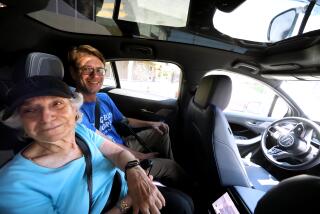A test drive of hands-free texting
- Share via
Britney does it.
So does my boss. What about you? It’s texting while driving: the insanely attention-diverting practice of typing out messages on cellphones while barreling down the highway. A law against it in California is set to go into effect in July, but it applies only to drivers under the age of 18. Guess that leaves Britney Spears in the clear.
An abstinence campaign probably wouldn’t have much of an effect either, given how common texting has become as a form of communication.
The most obvious solution, other than self-control, is hands-free texting.
Ford Motor Co. is getting into the game. It will offer a technology upgrade called Sync as an option for some 2008 cars. Among other functions, it can read aloud, via computer voice, incoming text messages. But Sync won’t send messages, which makes for a one-sided conversation.
There are a few products on the market, and more to come, that enable you to send text messages without any pesky typing, directly from your phone.
Not all of them rely solely on technology. Some use human transcribers in India or elsewhere who listen to your spoken message (an impetus for keeping it clean) and then send it along as text.
Others employ voice-to-text technology.
Neither type is infallible. And none of the services tested for this article provided a complete solution.
Because the problem is relatively new, the remedies are in their early stages. Still, some showed promise.
Jott
The test message came out this way: “It actually turns my text to speech, which is kinda the idea if I was in the choir and doing this.”
I was not in a choir, thank goodness for anyone who has heard me try to even hum a tune. The word I actually said, while testing Jott, was “car.”
Someone, most likely offshore, listened to my test message and got the word wrong. In addition, the entire message was presented almost without periods in long, run-on sentences. But slang words, such as kinda, were spelled perfectly.
Maybe the transcriber was learning English from “Welcome Back, Kotter” reruns.
John Pollard, chief executive of Jott, acknowledged that mistakes would be made. But a transcriber is more reliable than currently available speech-to-text programs, he maintained.
“There is no way that speech technology, by itself, can be used over a cellphone in a wide variety of situations,” Pollard said.
The messages were understandable if you didn’t take them literally, and they arrived about 15 minutes after being spoken -- not bad considering the human intervention.
Jott, which is still in its preview release, is free to use and Pollard said the company plans to keep it that way, relying on revenue from display advertisements that appear on the text versions of the messages.
Setting up the program is easy. You register online and list the people you’re likely to text, including their e-mail addresses and cellphone numbers.
Then when you’re out driving, you call Jott’s toll-free number. Presumably, you’ll use a voice dialing program or at least speed-dial -- otherwise, why bother with hands-free texting? The computer that answers recognizes your cellphone number and makes your contact list available.
You say the name of the person you want to text and then you say the message.
Unfortunately, Jott is a one-way system: It can’t work in reverse to translate incoming text messages into speech.
If someone texts you, fight the urge to read it until you can pull over. Or hope for a traffic jam that will bring you to a stop.
EVA
This is a two-way service. EVA, or Electronic Virtual Assistant, delivers messages to you by voice and then allows you to respond, mostly hands-free.
But the program was so problematic during testing that I nicknamed it “Eva Destruction” after a famed drag performer.
Here is the way it’s supposed to work: You sign up for the service, which EVA calls E-max, and list your VIP contacts. Whenever someone on the list sends you an e-mail, you get a phone call from a computer that reads the message to you. It’s kind of like getting a call from Stephen Hawking, without the brilliance.
At the end of the message, you get the opportunity to respond by recording a reply that goes out as an e-mail attachment.
The limitations start with the fact that the system can’t be used to leave a text message on a phone; it works only with e-mail. Worse, it doesn’t work with all e-mail services.
To sign up for the service, you must have a POP3 e-mail account from a commercial provider such as EarthLink or Charter. Free e-mail accounts from services such as Yahoo or Google usually won’t work, however. And some corporate accounts (latimes.com is an example) won’t cut it with EVA.
Even if you have an e-mail account that the texting service finds agreeable, it might not welcome all messages.
You can try it free for 30 days, then it costs $20 a month.
They’re starting small. Every time I called customer service, I got the same person and sometimes I could hear her baby crying it the background.
EVA’s hands-free texting service might end up being of value, but it has a lot of technical hurdles to overcome before it can be a real player.
Yap
This service will not be available until next year, and it’s not clear if it will be offered to everyone or only through certain cellphone service providers.
But Yap has gotten a lot of buzz, at least partly because its voice recognition software seems so accomplished, even over a cellphone line. It can even translate into texting-style syntax.
For example, say “Where do you want to go tonight?” into a phone loaded with Yap software, and it translates it as “Where do u want 2 go 2night?,” using the contractions that hard-core texters employ.
It could just as easily use the full words, but that would not be cool, according to Yap’s founder, Igor Jablokov.
“That way, their friends don’t think they text like a nerd,” he said.
--
(BEGIN TEXT OF INFOBOX)
Text talk
Common sense hasn’t curbed texting in cars, but voice-to-text services might make it safer.
Jott
Function: Speech-to-text for outgoing messages
Method: Human transcribers
Cost: Free
Info: www.jott.com
Pluses: Easy to setup and use; works with e-mails and direct-to-phone texting.
Minuses: Transcriptions are hit-and-miss; works only on outgoing texting; a stranger is reading your messages.
EVA
Function: Incoming e-mails converted to speech; replies sent as audio attachments.
Method: Computer voice
Cost: Hands-free e-mail is free for 30 days, then $20 a month.
Info: www.evaforhire.com
Pluses: E-mails processed quickly; user can reply using voice.
Minuses: Not all types of e-mail accounts can be used; can’t text to phones.
Yap (coming in 2008)
Function: Incoming and outgoing messages
Method: Voice-to-text software
Cost: Not determined
Info: www.yapme.com
Pluses: Software function is impressive.
Minuses: Too early to tell
Source: Times research
More to Read
The biggest entertainment stories
Get our big stories about Hollywood, film, television, music, arts, culture and more right in your inbox as soon as they publish.
You may occasionally receive promotional content from the Los Angeles Times.











